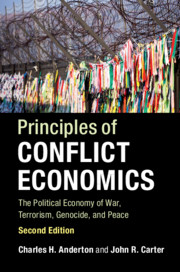Book contents
- Principles of Conflict Economics
- Principles of Conflict Economics
- Copyright page
- Dedication
- Contents
- Figures
- Tables
- Preface and Acknowledgments
- Part I Introduction
- Part II Key Concepts and Models for the Economic Analysis of Conflict and Peace
- Part III Economic Aspects of War, Terrorism, and Genocide
- Part IV Security and Peace
- Appendix A Brief Primer on Weapons Technologies
- Appendix B Formal Bargaining Model of War and Peace
- Appendix C Matrix Algebra Methods for Solving Network Models
- Appendix D Conflict and Peace Datasets
- Appendix E Regression Methods
- References
- Author Index
- Subject Index
- References
References
Published online by Cambridge University Press: 09 April 2019
- Principles of Conflict Economics
- Principles of Conflict Economics
- Copyright page
- Dedication
- Contents
- Figures
- Tables
- Preface and Acknowledgments
- Part I Introduction
- Part II Key Concepts and Models for the Economic Analysis of Conflict and Peace
- Part III Economic Aspects of War, Terrorism, and Genocide
- Part IV Security and Peace
- Appendix A Brief Primer on Weapons Technologies
- Appendix B Formal Bargaining Model of War and Peace
- Appendix C Matrix Algebra Methods for Solving Network Models
- Appendix D Conflict and Peace Datasets
- Appendix E Regression Methods
- References
- Author Index
- Subject Index
- References
- Type
- Chapter
- Information
- Principles of Conflict EconomicsThe Political Economy of War, Terrorism, Genocide, and Peace, pp. 441 - 481Publisher: Cambridge University PressPrint publication year: 2019



